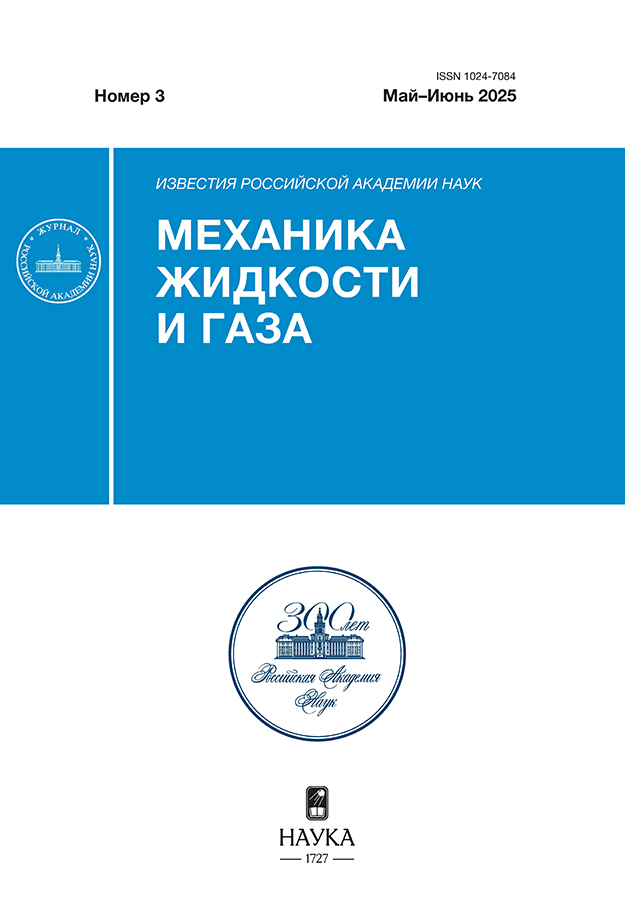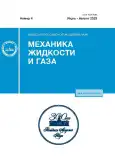Nonisothermal Fluid Flow in a Well during Induction Heating of the Casing String
- Authors: Davletshin F.F.1, Akchurin R.z.1, Sharafutdinov R.F.1, Islamov D.F.1
-
Affiliations:
- Ufa University of Sciences and Technologies
- Issue: No 4 (2023)
- Pages: 81-92
- Section: Articles
- URL: https://journals.rcsi.science/1024-7084/article/view/135100
- DOI: https://doi.org/10.31857/S1024708423600045
- EDN: https://elibrary.ru/WKQWVX
- ID: 135100
Cite item
Full Text
Abstract
The distinctive features of the flow velocity and temperature fields of ascending fluid flow in a metal round pipe (round casing string installed in a production well) under the conditions of its local induction heating are studied. The results of investigation are based on numerical solution of the Navier–Stokes equations in the Boussinesq–Oberbeck approximation. The calculations were performed using the Ansys Fluent software package (license ANSYS Academic Research CFD under the agreement with the Bashkir State University dated June 15, 2020). The fluid flow rates of 10 and 50 m3 per day are considered. Such flow rates correspond to the laminar and transitional flow regimes in the casing pipe. It is found that local perturbations of the velocity and temperature fields are presented in the near-wall region of the heated casing. Fluid temperature perturbations reach several Kelvin degrees, the local flow velocity which increases due to natural thermal convection in the near-wall region of the casing string being several times higher than the cross-section-average flow velocity. The occurrence of areas of vortex flow motion over the interval of induction heating due to natural thermal convection is shown.
About the authors
F. F. Davletshin
Ufa University of Sciences and Technologies
Email: felix8047@mail.ru
Ufa, Russia
R. z. Akchurin
Ufa University of Sciences and Technologies
Email: ac4urin.ruslan@yandex.ru
Ufa, Russia
R. F. Sharafutdinov
Ufa University of Sciences and Technologies
Email: gframil@inbox.ru
Ufa, Russia
D. F. Islamov
Ufa University of Sciences and Technologies
Author for correspondence.
Email: islamovden@rambler.ru
Ufa, Russia
References
- Яруллин Р.К., Яруллин А.Р., Валиуллин А.С., Валиуллин М.С., Тихонов И.Н. Оптимизация аппаратно-технологического комплекса промыслово-геофизических исследований действующих горизонтальных скважин // Проблемы сбора, подготовки и транспорта нефти и нефтепродуктов. 2020. Т. 126. № 4. С. 19–28.
- Валиуллин Р.А., Яруллин Р.К. Особенности геофизических исследований действующих горизонтальных скважин // Вестник АН Республики Башкортостан. 2014. № 1. С. 21–28.
- Катеев Т.Р. Повышение качества крепления скважин на нефтяных месторождениях Республики Татарстан // Записки горного института. 2004. Т. 159. № 2. 2004. С. 11–14.
- Токарев М.А., Зубаиров С.Г., Токарева Н.М. Промысловая эффективность усовершенствованной конструкции гидромеханического щелевого перфоратора // Изв. Томского политехнического ун-та. Инжиниринг георесурсов. 2018. Т. 329. № 7. С. 70–76.
- Valiullin R.A., Sharafutdinov R.F., Ramazanov A.Sh., Shilov A.A. Enhancement of well productivity using a technique of high-frequency induction treatment // SPE (Society of Petroleum Engineers) – 157724, SPE Heavy Oil Conference Canada, Calgary, Alberta, Canada, 12–14 June 2012. P. 1–7.
- Гаязов М.С., Валиуллин Р.А., Яруллин Р.К. Применение метода регулярных температурных меток для измерения фазовых расходов в низкодебитных горизонтальных скважинах // Вестник Тюменского гос. ун-та. Физико-математическое моделирование. Нефть, газ, энергетика. 2020. Т. 6. № 1. С. 150–165.
- Валиуллин Р.А., Шарафутдинов Р.Ф., Федотов В.Я., Канафин И.В., Космылин Д.В. Изучение тепловой конвекции на модели скважины с индукционным нагревателем при заколонном перетоке “сверху” // Вестник Башкирского ун-та. 2017. Т. 22. № 2. С. 325–329.
- Канафин И.В., Космылин Д.В. Изучение формирования теплового поля на модели скважины с локальным нагревом // Изв. Кабардино-Балкарского научного центра РАН. 2017. № 2. С. 44–48.
- Шварц К.Г., Шварц Ю.А. Устойчивость адвективного течения в горизонтальном слое несжимаемой жидкости при наличии условия проскальзывания Навье // Изв. РАН. Механика жидкости и газа. 2020. № 1. С. 33–44. https://doi.org/10.31857/S0568528120010119
- Андреев В.К., Гапоненко Ю.А., Гончарова О.Н., Пухначев В.В. Современные математические модели конвекции. М.: ФИЗМАЛИТ, 2008. 368 с.
- Bergman Th.L., Lavine A.S., Incropera F.P., DeWitt D.P. Fundamentals of heat and mass transfer, 8th edition. St. Joseph County: University of Notre Dame, Indiana, USA, 2006. 1070 p.
- Брыков Н.А. Решение нелинейной нестационарной задачи теплопроводности // Междунар. науч.-исслед. журн. 2016. № 5–3 (47). С. 52–55. https://doi.org/10.18454/IRJ.2016.47.137
- Замзари Ф., Мехрез З., Кафси А.Э. Интенсификация теплообмена в пульсирующем течении внутри открытой полости под действием равномерного магнитного поля // Изв. РАН. Механика жидкости и газа. 2019. № 3. С. 138–149. https://doi.org/10.1134/S0568528119020142
- Ansys 2022R1 Documentation. Ansys Fluent Theory Guide. Ansys Inc., Southpointe, 2022. 1036 p.
- Сентябов А.В., Гаврилов А.А., Дектерев А.А. Исследование моделей турбулентности для расчета закрученных течений // Теплофизика и аэромеханика. 2011. Т. 18. № 1. С. 81–93.
- Alim M.A., Rahman M., Karim M. Performance of SST k–ω turbulence model for computation of viscous drag of axisymmetric underwater bodies // International Journal of Engineering. 2011. № 24 (2). P. 139–146.
Supplementary files

















